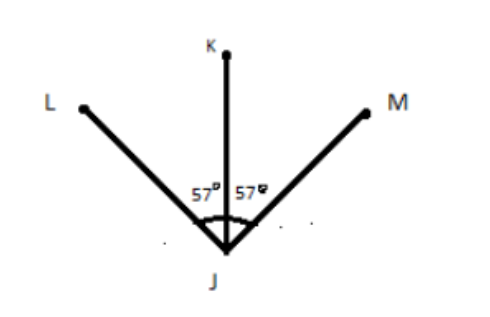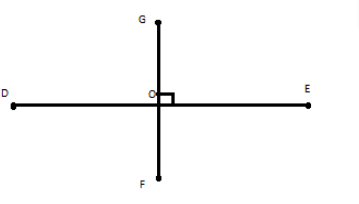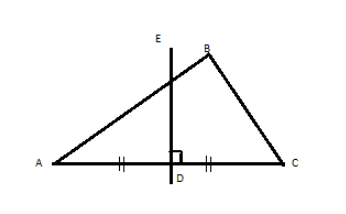
What is the difference between a Bisector and a Perpendicular bisector?
Answer
507.9k+ views
Hint: Here In this question, we have to explain about the difference between a bisector and a perpendicular bisector. In Geometry, Bisector is a line that divides the line into two different or equal parts. Similarly a perpendicular bisector is a line which intersects a given line segment at a \[{90^ \circ }\] degree, and also it passes through the midpoint of the line segment.
Complete step-by-step answer:
Bisector - A Bisector is any segment, line that splits another line into two congruent (equal) parts. It is applied to both angles and line segments.

Angle bisector: A line that cuts an angle into two equal parts. In figure, the line \[JK\] bisects the angle \[\left| \!{\underline {\,
{LJM} \,}} \right. \]. The line \[JK\] is called bisector
When, the line\[JK\] bisects the angle \[\left| \!{\underline {\,
{LJM} \,}} \right. \], then
\[ \Rightarrow \,\left| \!{\underline {\,
{LJK} \,}} \right. = \left| \!{\underline {\,
{MJK} \,}} \right. \]
Perpendicular Bisector - A line or ray that cuts a line segment into two equal parts at \[{90^0}\]
In Perpendicular bisector, the bisector always crosses (cuts) the line segment (or line) at right angles at 90 degree (\[{90^0}\])
In the below figure, the line \[GF\] bisect the line \[DE\] with angle \[{90^0}\]and \[OG\] is the perpendicular bisector of \[DE\] since \[DE\] splits into two congruent segments \[DO\] and \[OE\].

In the triangle \[ABC\], \[ED\] bisect the line \[AC\], \[ED\] is perpendicular to \[AC\] and here triangle\[ABC\]Split into one right angle triangle and one quadrilateral

Note: Bisectors used to construct Geometrical shapes and by using perpendicular bisectors we can construct minimum one right angle triangle.
Finding the perpendicular bisector is helpful in other fields like archaeology. By carefully plotting three points on the plates circular rim, the archaeologist can reconstruct the original plates diameter from the two perpendicular bisectors of the chord of rim.
Complete step-by-step answer:
Bisector - A Bisector is any segment, line that splits another line into two congruent (equal) parts. It is applied to both angles and line segments.

Angle bisector: A line that cuts an angle into two equal parts. In figure, the line \[JK\] bisects the angle \[\left| \!{\underline {\,
{LJM} \,}} \right. \]. The line \[JK\] is called bisector
When, the line\[JK\] bisects the angle \[\left| \!{\underline {\,
{LJM} \,}} \right. \], then
\[ \Rightarrow \,\left| \!{\underline {\,
{LJK} \,}} \right. = \left| \!{\underline {\,
{MJK} \,}} \right. \]
Perpendicular Bisector - A line or ray that cuts a line segment into two equal parts at \[{90^0}\]
In Perpendicular bisector, the bisector always crosses (cuts) the line segment (or line) at right angles at 90 degree (\[{90^0}\])
In the below figure, the line \[GF\] bisect the line \[DE\] with angle \[{90^0}\]and \[OG\] is the perpendicular bisector of \[DE\] since \[DE\] splits into two congruent segments \[DO\] and \[OE\].

In the triangle \[ABC\], \[ED\] bisect the line \[AC\], \[ED\] is perpendicular to \[AC\] and here triangle\[ABC\]Split into one right angle triangle and one quadrilateral

Note: Bisectors used to construct Geometrical shapes and by using perpendicular bisectors we can construct minimum one right angle triangle.
Finding the perpendicular bisector is helpful in other fields like archaeology. By carefully plotting three points on the plates circular rim, the archaeologist can reconstruct the original plates diameter from the two perpendicular bisectors of the chord of rim.
Recently Updated Pages
Master Class 8 Maths: Engaging Questions & Answers for Success

Class 8 Question and Answer - Your Ultimate Solutions Guide

Master Class 12 Economics: Engaging Questions & Answers for Success

Master Class 12 Maths: Engaging Questions & Answers for Success

Master Class 12 Biology: Engaging Questions & Answers for Success

Master Class 12 Physics: Engaging Questions & Answers for Success

Trending doubts
What is BLO What is the full form of BLO class 8 social science CBSE

Which one of the following groups comprises states class 8 social science CBSE

Citizens of India can vote at the age of A 18 years class 8 social science CBSE

Full form of STD, ISD and PCO

A couple went for a picnic They have 5 sons and each class 8 maths CBSE

Right to vote is a AFundamental Right BFundamental class 8 social science CBSE




